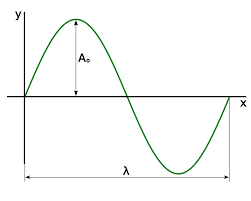9th Grade > Physics
SOUND MCQs
Total Questions : 57
| Page 2 of 6 pages
Answer: Option A. -> √20+0.3 s
:
A
The question can be divided into two parts, where in the first part, thetime taken by the pebble to reach the bottom is calculated and in thesecond part, the time taken by the sound wave to reach the top is calculated.
Given:
Initial velocity,u=0ms−1
Depth of the well, s=100m
Acceleration, a=10ms−2
Speed of sound, v=343ms−1
Let t1 be the time taken by the pebble to hit the bottom.
From second equation of motion,
s=ut1+12at21
100=(0×t1)+(12×(10)×t21)
100=5t21
⇒t1=√20s
We know, time=distancespeed
Let t2 be the time taken for the sound wave to reach from the bottom to the top of the well.
t2=sv=100343≈0.3s
Total time,
t=t1+t2
=√20+0.3s.
:
A
The question can be divided into two parts, where in the first part, thetime taken by the pebble to reach the bottom is calculated and in thesecond part, the time taken by the sound wave to reach the top is calculated.
Given:
Initial velocity,u=0ms−1
Depth of the well, s=100m
Acceleration, a=10ms−2
Speed of sound, v=343ms−1
Let t1 be the time taken by the pebble to hit the bottom.
From second equation of motion,
s=ut1+12at21
100=(0×t1)+(12×(10)×t21)
100=5t21
⇒t1=√20s
We know, time=distancespeed
Let t2 be the time taken for the sound wave to reach from the bottom to the top of the well.
t2=sv=100343≈0.3s
Total time,
t=t1+t2
=√20+0.3s.
Answer: Option C. -> Frequency in A = Frequency in B
:
C
The frequency ofsound waves depends only on the frequency of vibration of the source of sound. Itdoesnot depend on the medium of propogation. Thus, the frequency of sound in bothmedia are same.
:
C
The frequency ofsound waves depends only on the frequency of vibration of the source of sound. Itdoesnot depend on the medium of propogation. Thus, the frequency of sound in bothmedia are same.
Answer: Option B. -> False
:
B
Particles in a longitudinal waveoscillate along the directionof the wave propagation. Sound wave is an exampleof thelongitudinal wave.
:
B
Particles in a longitudinal waveoscillate along the directionof the wave propagation. Sound wave is an exampleof thelongitudinal wave.
Answer: Option A. -> 1
:
A
Speed of sound in a medium is a characteristic of the medium and temperature.
v∝√T√ρM
where:
v: Speed of sound
T: Temperature
ρ: Density
M: Molecular Mass of the medium
Increasing time period decreases the frequency of the wave.
v=fλ still holds because wavelength increases to maintain the speed of the wave in the medium.
:
A
Speed of sound in a medium is a characteristic of the medium and temperature.
v∝√T√ρM
where:
v: Speed of sound
T: Temperature
ρ: Density
M: Molecular Mass of the medium
Increasing time period decreases the frequency of the wave.
v=fλ still holds because wavelength increases to maintain the speed of the wave in the medium.
Answer: Option B. -> It is more in solid state as compared to the gaseous state.
:
B
Sound wave travels fastest in solids, faster in liquids and slower in gases.
Temperature is the average kinetic energy of all the particles of a body. When the temperature increases for a given state of matter, the movement of particles increases and so does the speed of sound.
:
B
Sound wave travels fastest in solids, faster in liquids and slower in gases.
Temperature is the average kinetic energy of all the particles of a body. When the temperature increases for a given state of matter, the movement of particles increases and so does the speed of sound.
Answer: Option D. -> Eardrum
:
D
Ear drum is the part of the ear that vibrates in response to the sound waves.The eardrum is a thin flap of skin that is stretched tight like a drum and vibrates when sound hits it. These vibrations move the tiny bones of the middle ear which send vibrations to the inner ear.
:
D
Ear drum is the part of the ear that vibrates in response to the sound waves.The eardrum is a thin flap of skin that is stretched tight like a drum and vibrates when sound hits it. These vibrations move the tiny bones of the middle ear which send vibrations to the inner ear.
Answer: Option C. -> 850 m
:
C
Let, the distance between the source of sound and the reflecting surface be d
Hence, total distance the sound travels is: d′=2d
Given,
Timetaken for the echo to reach the source, t=5s
Speed of the sound wave, v=340ms−1
From formula of speed,
v=2dt
5=2d340
⟹d=850m
:
C
Let, the distance between the source of sound and the reflecting surface be d
Hence, total distance the sound travels is: d′=2d
Given,
Timetaken for the echo to reach the source, t=5s
Speed of the sound wave, v=340ms−1
From formula of speed,
v=2dt
5=2d340
⟹d=850m
Answer: Option D. -> time period
:
D
The time taken by two consecutive compressions or rarefactions to cross a fixed point is called the time period of the wave. The relation between time period 'T' and frequency 'F' is:
T=1F
:
D
The time taken by two consecutive compressions or rarefactions to cross a fixed point is called the time period of the wave. The relation between time period 'T' and frequency 'F' is:
T=1F
Answer: Option C. -> 1470
:
C
Given:
Distance between source and observer, s=1000m
Velocity of sound, v=340ms−1
Frequency of sound, f=500Hz
Time taken for the sound wave to reach the observer from the source is:
t=sv
Number of oscillations in 1s is the frequency, f
Number of oscillations in time t will be:
n=tf
n=svf
n=1000×500340
n≈1470
:
C
Given:
Distance between source and observer, s=1000m
Velocity of sound, v=340ms−1
Frequency of sound, f=500Hz
Time taken for the sound wave to reach the observer from the source is:
t=sv
Number of oscillations in 1s is the frequency, f
Number of oscillations in time t will be:
n=tf
n=svf
n=1000×500340
n≈1470

















